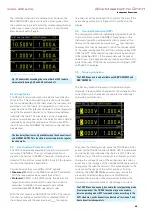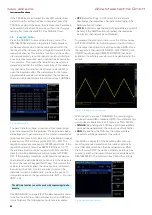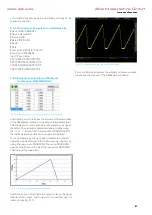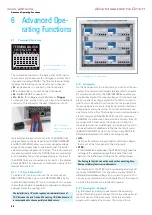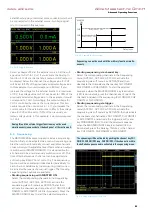
62
Remote Control
62
Remote Control
10.3.1 IP networks (IP – Internet protocol)
In order that two or several network elements (e.g. measu-
ring instruments, host/PC‘s, …) can communicate over a
network with one another, some fundamental connections
have to be considered, so that data communication is error
free and unimpaired.
For each element in a network an IP address has to be
assigned, so that they can exchange data among them-
selves. IP addresses are represented (with the IP version
4) as four decimal numbers separated by points (e.g.
192.168.15.1). Each decimal number is represented by
a binary number of 8 bits. IP addresses are divided into
public and private address ranges. Public IP addresses will
be able to route by the Internet and an Internet service
Provider (ISP) can to be made available. Public IP addres-
ses can be reached directly over the Internet to directly
exchange internet data. Private IP addresses are not
routed by the Internet and are reserved for private net-
works. Network elements with private IP addresses cannot
be reached directly over the Internet so no data can be
directly exchanged over the Internet. To allow network
elements with a private IP address to exchange data over
the Internet, they require a router for IP address conversion
(English NAT; Network address translation), before con-
nection to the Internet. The attached elements can then
data exchange over this router, which possesses a private
IP address (LAN IP address) and also a public IP address
(WAN IP address), via the Internet.
If network elements exchange data only over a local net-
work (without connection with the Internet), appropriate
use private IP addresses. Select in addition e.g. a private IP
address for the instrument and a private IP address for the
host (PC), with which you would like to control the instru-
ment. If you might connect your private network with the
Internet later via a router, the private IP addresses used in
your local network can be maintained. Since within each
IP address range the first IP address is used as network
IP address and the last IP address is used as Broadcast IP
address, in each case two IP addresses have to be taken
off from the “number of possible host addresses“ (see
table 1: Private IP address ranges).
Apart from the organization of IP addresses into public and
private address ranges, IP addresses are also divided into
classes (Class: A, B, C, D, E). Within the classes A, B, and
C are also include the private IP of address ranges descri-
bed before. The categorisation from IP addresses is for
the assignment of public IP address ranges of importance
and essentially depends on the size of a local network
(maximum number of hosts in the network), which is to
be connected with the Internet (see table 2: Classes of
IP addresses). IP addresses can fix (statically) or variable
(dynamically) to be assigned. If IP addresses in a network
are assigned fix, an IP address must be preset manually
with each network element. If IP addresses in a network
are assigned to the attached network elements automati-
cally (dynamically), a DHCP server (English DHCP beco-
mes; Dynamic Host Configuration Protocol) is required for
the dispatching of IP addresses. With a DHCP server an IP
address range for the automatic dispatching of IP addres-
ses can be preset. A DHCP server is usually already inte-
grated in a router (DSL router, ISDN router, Modem router,
WLAN router, …) integrated. If a network element (e.g.
an instrument) is connected by a network cable directly
with a host (PC), the IP addresses cannot be assigned to
the instrument and the host (PC) automatically, since no
network with DHCP server is present here. They have to
be preset therefore at the instrument and at the host (PC)
manually.
IP addresses are divided by using subnet mask into a
network quota and into a host quota, so similarly e.g. a
telephone number is divided in pre selection (land and lo-
cal area network number) and call number (user number).
Subnet mask have the same form as IP addresses. They
are represented with four decimal numbers separated
by points (e.g. 255.255.255.0). As is the case for the IP
addresses here each decimal number represents a binary
number of 8 bits. The separation between network quota
and host quota is determined by the subnet mask within
an IP address (e.g. the IP address 192.168.10.10 by the sub-
net mask 255.255.255.0 is divided into a network quota
192.168.10.0 and a host quota of 0.0.0.10). The allocation
takes place via the transformation of the IP address and
the subnet mask in binary form and afterwards a bit by bit
class
adress range
net quota
host quota max. number of networks max. number of hosts
A
0.0.0.1 - 127.255.255.255
8 Bit
24 Bit
126
16.777.214
B
128.0.0.1 - 191.255.255.255
16 Bit
16 Bit
16.384
65.534
C
192.0.0.1 - 223.255.255.255
24 Bit
8 Bit
2.097.151
254
D
224.0.0.1 - 239.255.255.255
Reserved for multicast applications
E
240.0.0.1 - 255.255.255.255
Reserved for special applications
Table 10.2: Classes of IP adresses
adress range
subnetz mask
CIDR way of writing
number of possible host adresses
10.0.0.0 –10.255.255.255
255.0.0.0
10.0.0.0/8
2
24
− 2 = 16.777.214
172.16.0.0 –172.31.255.255
255.240.0.0
172.16.0.0/12
2
20
− 2 = 1.048.574
192.168.0.0 –192.168.255.255
255.255.0.0
255.255.255.0
192.168.0.0/16
192.168.0.0/24
2
16
− 2 = 65.534
2
8
− 2 = 254
Table 10.1: Private IP adress ranges
www.allice.de
Allice Messtechnik GmbH
Содержание 3593.1006.02
Страница 2: ...www allice de Allice Messtechnik GmbH ...
Страница 3: ...71 Appendix 71 Appendix www allice de Allice Messtechnik GmbH ...
Страница 37: ...35 Anhang 35 Anhang www allice de Allice Messtechnik GmbH ...
Страница 39: ...www allice de Allice Messtechnik GmbH ...
Страница 40: ...71 Appendix 71 Appendix www allice de Allice Messtechnik GmbH ...
Страница 73: ...68 Appendix 68 Appendix www allice de Allice Messtechnik GmbH ...
Страница 74: ...69 Appendix 69 Appendix www allice de Allice Messtechnik GmbH ...
Страница 75: ...70 Appendix 70 Appendix www allice de Allice Messtechnik GmbH ...


